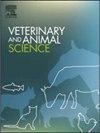Phenotypic characterization of indigenous Xhosa goat ecotype in three agro-ecological zones in the eastern cape province, South Africa
IF 1.9
Q2 AGRICULTURE, DAIRY & ANIMAL SCIENCE
引用次数: 0
Abstract
This study characterized the phenotypic attributes of indigenous Xhosa goats across three agro-ecological zones and developed predictive models for estimating body weight. A total of 450 Xhosa goats were sampled using a stratified random approach based on sex, age, and agro-ecological region. Morphometric traits, including body weight (BW), heart girth (HG), body length (BL), wither height (WH), and body depth (RD), were recorded. Data were analysed using the General Linear Model (GLM) of SPSS (v.20) to assess the effects of zones, sex, and age on body traits, while Pearson’s correlation and stepwise regression identified the best predictors of body weight. Results showed significant (p < 0.05) variations in body measurements across zones, with Savanna goats exhibiting superior traits. Males had significantly (p < 0.05) higher BW and body dimensions than females and castrates. Correlation analysis revealed HG (r=0.80), BL (r=0.84), and RD (r=0.82) as the strongest predictors of BW in males, while BL (r=0.66), HG (r=0.65), WH (r=0.62), and RD (r=0.61) were best for females. Stepwise regression identified HG and BL as the best predictors for males, and HG, BL, and SH for females. The predictive models (R² = 0.74–0.85) provide a practical tool for estimating body weight in field conditions. These findings provide practical tools for field-based weight estimation and highlight the importance of conserving the phenotypic diversity of Xhosa goats for sustainable breeding and genetic improvement programs in South Africa.
南非东开普省三个农业生态区土著科萨山羊生态型的表型特征
本研究分析了三个农业生态区科萨山羊的表型特征,并建立了体重预测模型。采用基于性别、年龄和农业生态区的分层随机抽样方法,共取样450只科萨山羊。记录体质量(BW)、胸围(HG)、体长(BL)、枯高(WH)、体深(RD)等形态计量学性状。使用SPSS (v.20)的一般线性模型(GLM)对数据进行分析,以评估区域、性别和年龄对身体特征的影响,而Pearson相关和逐步回归确定了体重的最佳预测因子。结果显示,不同地区的身体测量值存在显著差异(p < 0.05),草原山羊表现出优越的性状。公鼠的体重和体尺显著高于母鼠和去势鼠(p < 0.05)。相关性分析显示,HG (r=0.80)、BL (r=0.84)和RD (r=0.82)是男性体重的最强预测因子,而BL (r=0.66)、HG (r=0.65)、WH (r=0.62)和RD (r=0.61)是女性体重的最佳预测因子。逐步回归发现HG和BL是男性的最佳预测因子,而HG、BL和SH是女性的最佳预测因子。预测模型(R²= 0.74-0.85)为在野外条件下估计体重提供了实用的工具。这些发现为基于田间的体重估计提供了实用工具,并强调了保护科萨山羊表型多样性对南非可持续育种和遗传改良计划的重要性。
本文章由计算机程序翻译,如有差异,请以英文原文为准。
求助全文
约1分钟内获得全文
求助全文
来源期刊

Veterinary and Animal Science
Veterinary-Veterinary (all)
CiteScore
3.50
自引率
0.00%
发文量
43
审稿时长
47 days
 求助内容:
求助内容: 应助结果提醒方式:
应助结果提醒方式:


